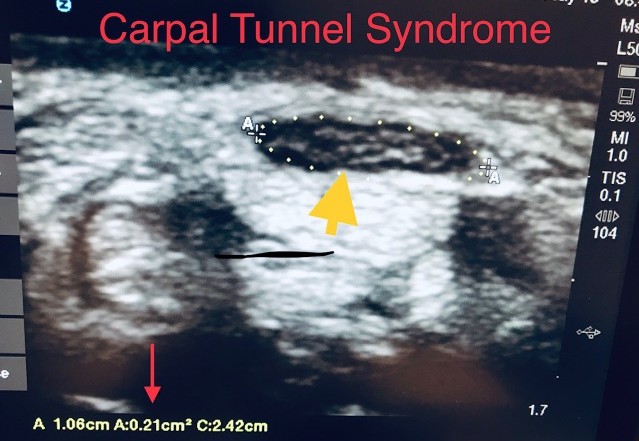
Carpal Tunnel Syndrome is a familiar and very common condition which affects approximately 3% – 6% of the entire population. However, it is not the only cause of hand pain and numbness. Other conditions such as tendonitis, Cubital Tunnel Syndrome, diabetic neuropathy or a pinched nerve in the cervical spine can all cause similar symptoms. Although the patient’s history and physical examination are useful in narrowing down the diagnosis, special tests are very helpful in confirming the diagnosis, especially in cases where symptoms are atypical. Until recently, electrodiagnostic tests in the form of nerve conduction studies and electromyography were considered the ‘gold standard,’ although false positives and false negatives could occur in up to 30% of cases.
Electrodiagnostic testing is uncomfortable, time consuming and expensive. Recent studies have found that ultrasound imaging of the carpal tunnel is highly accurate in the diagnosis of Carpal Tunnel Syndrome. Specifically, if the cross-sectional area of the median nerve, measured at the entrance of the carpal tunnel with ultrasound, is greater than 10mm², there is a 91% – 94% chance that the person has Carpal Tunnel Syndrome. Similarly, if the cross-sectional area of the median nerve is measured via ultrasound to be less than 10mm², there is a 96% – 99% chance that the person does not have Carpal Tunnel Syndrome. This occurs because, as Carpal Tunnel Syndrome worsens, the median nerve becomes increasingly swollen and flattened as it continues to be compressed beneath the transverse carpal ligament.
Figure 1 is a cross-sectional ultrasound image of a normal wrist at the entrance of the carpal tunnel. The median nerve (yellow arrow) is round and has a cross-sectional area of 5mm² (0.5 cm²; red arrow). In contrast, Figure 2 is an ultrasound image of a patient with Carpal Tunnel Syndrome. Note the flattened and enlarged median nerve (yellow arrow) having an abnormal cross-sectional area of 21mm² (0.21 cm²; red arrow). Figure 3 illustrates the appropriate carpal tunnel ultrasound positioning.
Ultrasound is quick, painless, safe, widely available and more cost-effective than electrodiagnostic testing. Due to its simplicity and accuracy, we feel ultrasound should be the preferred first-line test to either confirm or rule out Carpal Tunnel Syndrome, with electrodiagnostic testing reserved for complex clinical situations, recurrent cases, or to quantify the severity of nerve damage.
Sincerely,
Daniel Penello, MD

Figure 1

Figure 2

Figure 3